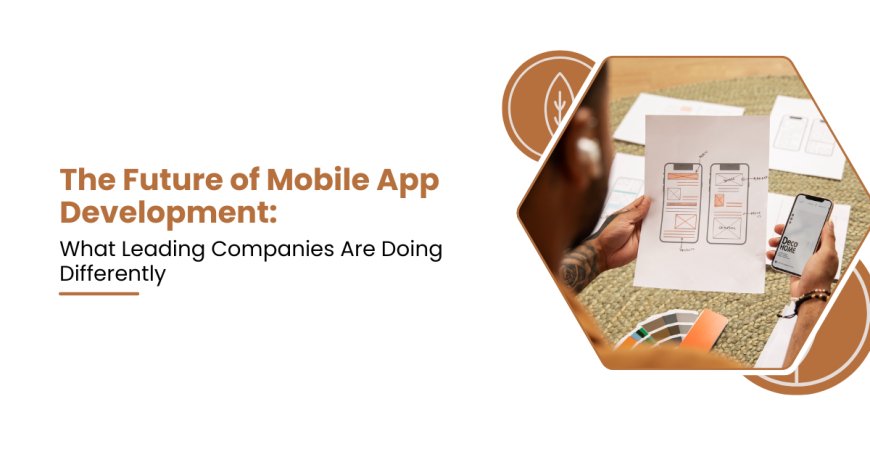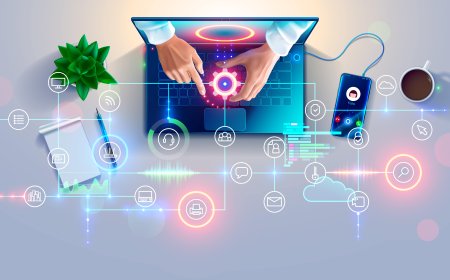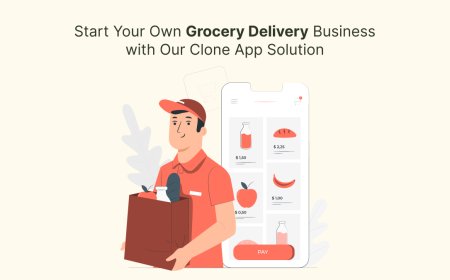The Future of Mobile App Development What Leading Companies Are Doing Differently
Discover how top tech companies are shaping the future of mobile app development. Learn the latest trends, tools, and innovative strategies that set industry leaders apart in 2025.

In 2024, the global mobile app economy generated approximately $693?billion in revenue and saw over 260?billion downloads, reflecting a steady annual growth rate near 15%. Mobile apps continue to hold users attention, with people spending an average of 4.5 hours daily on devices. This surge drives user retention, brand loyalty, and direct communication channels. Top-tier Mobile App Development Company firms recognize these trends and adapt swiftly. They integrate fresh technologies, implement quality-driven engineering practices, and develop future-ready user experiences. It draws on data, real-world examples, and technical insight, helping professionals map a path to advanced mobile development.
Adaptive Architecture and Clean Design
Leading mobile engineering groups build modular applications through component-based design. Using React Native, Flutter, or Jetpack Compose, developers define reusable UI components. This design speeds up development cycles by nearly 40 percent, fosters code maintainability, and ensures consistent user experience across screens.
Backends also evolve. Instead of monolithic architectures, companies implement microservices. Netflix, for example, observed a 70% reduction in time-to-release after migrating to microservices. API-first design using REST or GraphQL ensures all clients, whether mobile, web, or IoT, can interact uniformly. This approach reduces code duplication and accelerates new feature development.
Automated Pipelines and Environment-as-Code
Automation has become the foundation of mobile delivery. Tools like Jenkins, GitHub Actions, and CircleCI enable fully automated tests, lint checks, and builds with each commit. On the deployment side, services like Fastlane and Microsoft App Center automate distribution to testers or app stores. These practices reduce manual errors and cut time to market by roughly 30%.
Infrastructure-as-Code tools such as Terraform and AWS CloudFormation define staging, testing, and production environments as versioned code. With this setup, teams can replicate environments instantly and enforce consistency across multiple deployments. Debugging production issues becomes simpler since developers can spin up identical environments to diagnose problems.
Quality Engineering, Testing, and Observability
High-quality software remains a central theme for leading companies. They implement multi-layered testing architectures, including:
-
Unit tests for core logic
-
Integration tests for service interaction
-
UI tests via tools like Appium, Espresso, and XCTest
-
Performance testing to catch slow rendering or janky animations
These efforts target at least 80 percent automated coverage. Consequently, teams report a 35 percent drop in production bugs.
Production monitoring complements pre-release tests. SDKs such as Firebase Crashlytics, New Relic, and Sentry track real-time crashes, performance metrics, and user flows. Dashboards visualize latency spikes or area-specific errors, helping drive prioritized fixes.
Cross-Platform Development and Expanding Device Reach
To support both iOS and Android efficiently, many companies build on cross-platform solutions. Frameworks like React Native, Flutter, and Xamarin enable teams to reuse 7090% of their codebase across platforms. The result is faster releases and uniform UX.
Progressive Web Apps (PWAs) are also gaining ground. They deliver app-like experiences through the browser, offering offline capabilities and faster discovery without installations. Companies like Starbucks and Twitter have released PWAs to capture casual users.
On-Device AI and Smart Personalization
Mobile Intelligence enters a new era as AI runs natively on devices. TensorFlow Lite and Core ML power features like image classification, text recognition, and on-device translations all without server roundtrips. On-device AI delivers speed, privacy, and offline usability.
Personalization improves user engagement. Recommendation systems, similar to Netflix or news feeds, boost interaction by 2030 percent, improving retention and monetization. These systems rely on local behavior modeling, blended with cloud-powered analytics.
Voice and chat interfaces are also on the rise. Integrating chatbots through Dialogflow or Microsoft Bot Framework offers conversational experiences. SiriKit, Google Assistant, and Alexa SKDs bring voice interaction into apps, enhancing accessibility and convenience. The use of on-device AI and intelligent interfaces shows a shift toward more intuitive, adaptable, and private user experiences.
Privacy and Security as Built-in Features
Security and privacy are no longer afterthoughts. Leading Mobile App Development Company teams embed protection into every component. Data encryption is standard: Android apps use EncryptedSharedPreferences, while iOS stores data in the Keychain. Sensitive data never persists in logs or insecure storage.
Permission minimization has become critical. Apps only request necessary permissions, defaulting to granular, context-aware access. Android scoped storage and runtime permissions reduce friction and build trust. Reports show minimal permission requests can increase installs by 15 percent.
Security audits occur continuously. Static code analysis tools like SonarQube and Veracode inspect code for vulnerabilities. Teams follow OWASP Mobile Security Guidelines and perform regular penetration testing. This proactive security model reduces exploit risks and fosters user confidence.
UX Innovation: Fluid Experiences and Motion
Leading app developers differentiate through polished user interfaces. Adaptive layouts detect screen size changes whether on phones, foldables, tablets, or TVs adjusting UI components dynamically using tools like ConstraintLayout or Compose.
Motion design plays a pivotal role in communication flow. Shared-element transitions, parallax scrolling, and responsive feedback help users understand context. For instance, Flutters animations or Androids MotionLayout allow developers to create smooth transitions between UI states, reinforcing engagement and delight. This multi-faceted UX innovation enhances usability, accessibility, and emotional connection with users.
Supporting New Platforms and Emerging Use Cases
Foldables are entering the mainstream. Samsung and Google provide early access dev kits encouraging developers to design responsive split-screen layouts, dynamic hinge zones, and multi-app workflows. Leading apps adjust UI and behavior based on unfolding states.
Augmented reality continues expanding. ARKit, ARCore, and Unitys Vuforia systems enable immersive experiences for navigation, retail, and gaming. IKEA Place and Pokmon Go remain strong examples of applying AR for practical and entertainment purposes.
Also Read: How DevOps Transforms Mobile App Development: Core Roles and Responsibilities
Organizational Design and Culture
Leading companies restructure teams around cross-functional ownership. A typical squad includes mobile engineers on iOS and Android, backend developers, QA, UX designers, and DevOps specialists. This ownership model fosters collaboration, reduces bottlenecks, and accelerates decision-making.
Process maturity involves weekly retrospectives, story mapping, and pair programming. These rituals refine workflows and improve team cohesion.
Developers also use tools to reduce context switching. Shared SDKs provide logging, analytics, authentication, and onboarding templates. Automated living documentation (e.g., Swagger, Storybook, or internal wikis) keeps knowledge fresh and accessible.
Real-World Examples: What Top Companies Are Doing
Uber
Uber splits its ecosystem into modular components driver, rider, map engine, fare estimator and uses React Native within native shells. Backend services follow a microservices architecture with API-driven workflows. Feature flag-driven rollouts and automated pipelines enable rapid, safe updates.
Google uses Flutter for apps like Google Pay, Google Ads, and Stadia, sharing up to 90?percent of code across platforms. The hot reload feature significantly speeds debugging and iteration, saving engineering time by 40?percent.
Alibaba
Alibaba introduced mini-programs lightweight apps running inside its main app. This model eliminates installation friction, promotes faster loading, and provides a playground for third-party developers. The infrastructure supports high concurrency and security, becoming a central ecosystem for services.
Measuring Success and Operational Metrics
Leading teams define and track metrics aligned with business and technical goals. Typical metrics include:
-
Release frequency with daily or weekly deployment targets
-
Crash-free sessions above 99% stability
-
App size kept under 50?MB where feasible
-
Launch time reduced to under 2 seconds on mid-range devices
-
Engagement ratio (DAU/MAU) above 30 percent
-
Feature flag success rate and performance tracking
Platforms like Firebase Analytics, Microsoft App Center, Sentry, and Amplitude provide data insights and operational visibility.
Addressing Key Development Challenges
Device Fragmentation
With thousands of Android devices and multiple form factors, fragmentation remains a major test. Ahead-of-time solutions include device farms like AWS Device Farm and BrowserStack to test across varied environments.
Platform Parity
Maintaining feature parity across iOS, Android, web, and PWAs can degrade quality. Leading teams avoid divergence by sharing design systems and using shared UI libraries. CI flows build all versions simultaneously to catch issues early.
Regulatory Compliance
Privacy laws like GDPR, CCPA, and Indias data protection regulations require apps to implement consent flows, data access controls, and retention policies. Companies handle this through coded consent frameworks, API layers enforcing compliance, and documentation tied to audits.
Considering the Road Ahead
5G and Edge Computing
As 5G adoption spreads, ultra-low latency and bandwidth-heavy applications like cloud gaming, multi-user AR, and real-time collaboration become viable. Edge compute infrastructures and local device AI will combine to deliver low-lag experiences.
Low-Code and No-Code Development
Tools such as AppSheet, Mendix, Bubble, and FlutterFlow allow business teams to prototype or build internal apps. Full-stack teams integrate these tools into their pipelines, freeing them to focus on high-complexity development.
Decentralized Systems and Blockchain
Blockchain-based identity, credentialing, and payment systems are gaining attention. Experiments with decentralized login processes and mobile wallet integration are in early phases, with long-term potential for user control and interoperability.
Recommendations for Technical Leaders
If you're years into mobile development, these steps help future-proof your pipeline:
-
Adopt modular architecture and clean code separation.
-
Automate extensively from CI/CD to infrastructure ensuring reproducibility.
-
Emphasize comprehensive testing and real-time observability.
-
Integrate on-device AI and personalization thoughtfully.
-
Prioritize privacy and follow secure-by-design principles.
-
Build adaptable UX for modern platforms like foldables, AR, and vehicles.
-
Establish cross-functional teams with shared ownership and documentation-first practices.
-
Track both technical and business metrics across the entire delivery lifecycle.
-
Use edge technologies like 5G and blockchain strategically, not prematurely.
Conclusion
Mobile app development at scale now demands far more than UI polish. Leading companies view apps as ecosystems technically advanced, user-centric, secure, and adaptable. From clean architecture and infrastructure-as-code to AI, security, and emerging experiences, they engineer for tomorrows challenges.
By embracing these principles modular design, continuous delivery, intelligent features, privacy by design, broadened device support, and metrics-driven operations Mobile App Development Company teams can deliver quality, innovation, and business value. The future of mobile is broad, multi-device, smart, and secure. The road ahead belongs to teams who build with flexibility and foresight.






















